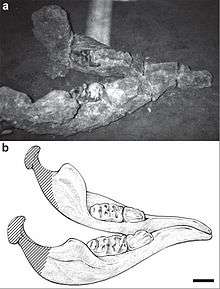Sinomammut
| Sinomammut Temporal range: Miocene, 12–11 Ma | |
|---|---|
 | |
| Mandible photograph and interpretive drawing. | |
| Scientific classification | |
| Kingdom: | Animalia |
| Phylum: | Chordata |
| Class: | Mammalia |
| Order: | Proboscidea |
| Family: | †Mammutidae |
| Genus: | †Sinomammut |
| Species: | †S. tobieni |
| Binomial name | |
| Sinomammut tobieni Mothé, 2016 | |
Sinomammut (meaning "Chinese Mastodon") is a proboscidean found in the Miocene of China. It was known from a single, fragmentary, mandible found in the 1990s. However, most of the specimen has been lost, leaving only the right ramus and an in-situ photograph of the mandible. The mandible was originally thought a gompothere closely related to Sinomastodon, but an analysis revealed it to actually be a mammutid that was a sister group to the well-known Mastodon. It can be distinguished from the mastodon by its lack of lower tusks.[1]
References
- ↑ Mothé, Dimila; Avilla, Leonardo S.; Zhao, Desi; Xie, Guangpu; Sun, Boyang; Mothé, Dimila; Avilla, Leonardo S.; Zhao, Desi; Xie, Guangpu. "A new Mammutidae (Proboscidea, Mammalia) from the Late Miocene of Gansu Province, China". Anais da Academia Brasileira de Ciências. 88 (1): 65–74. ISSN 0001-3765. doi:10.1590/0001-3765201520150261.
This article is issued from
Wikipedia.
The text is licensed under Creative Commons - Attribution - Sharealike.
Additional terms may apply for the media files.